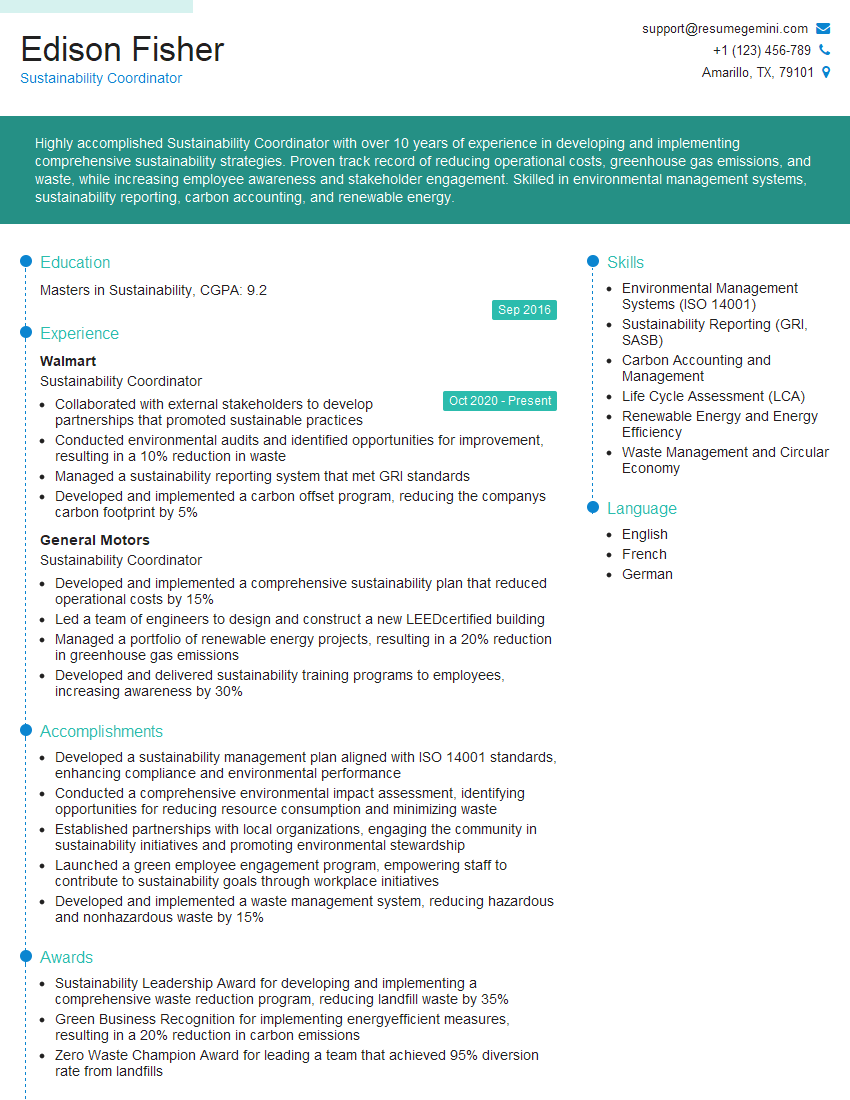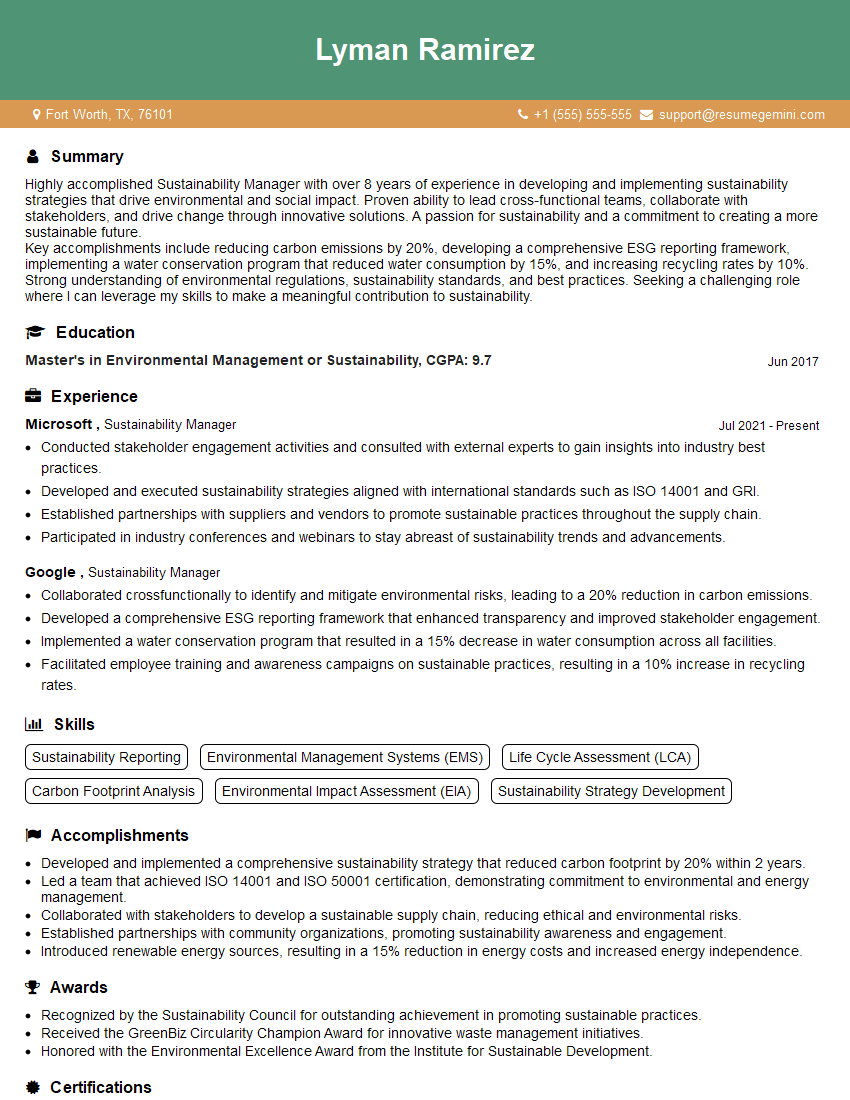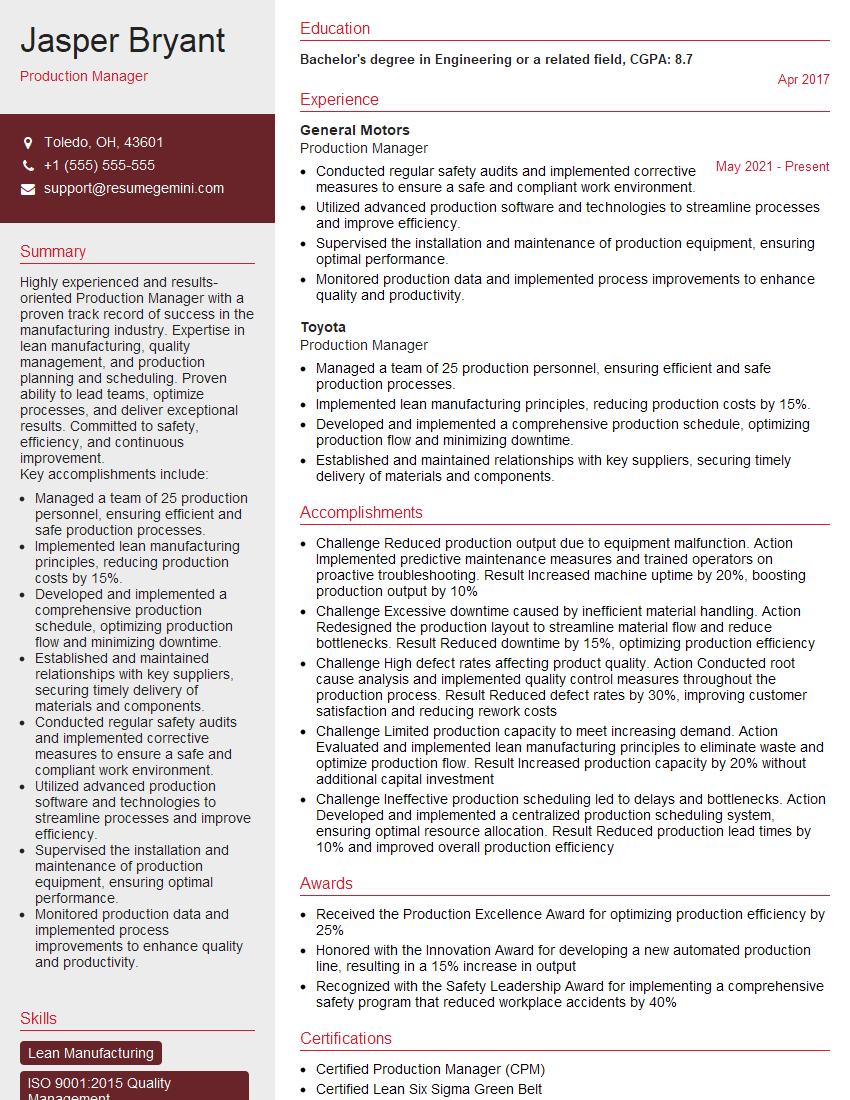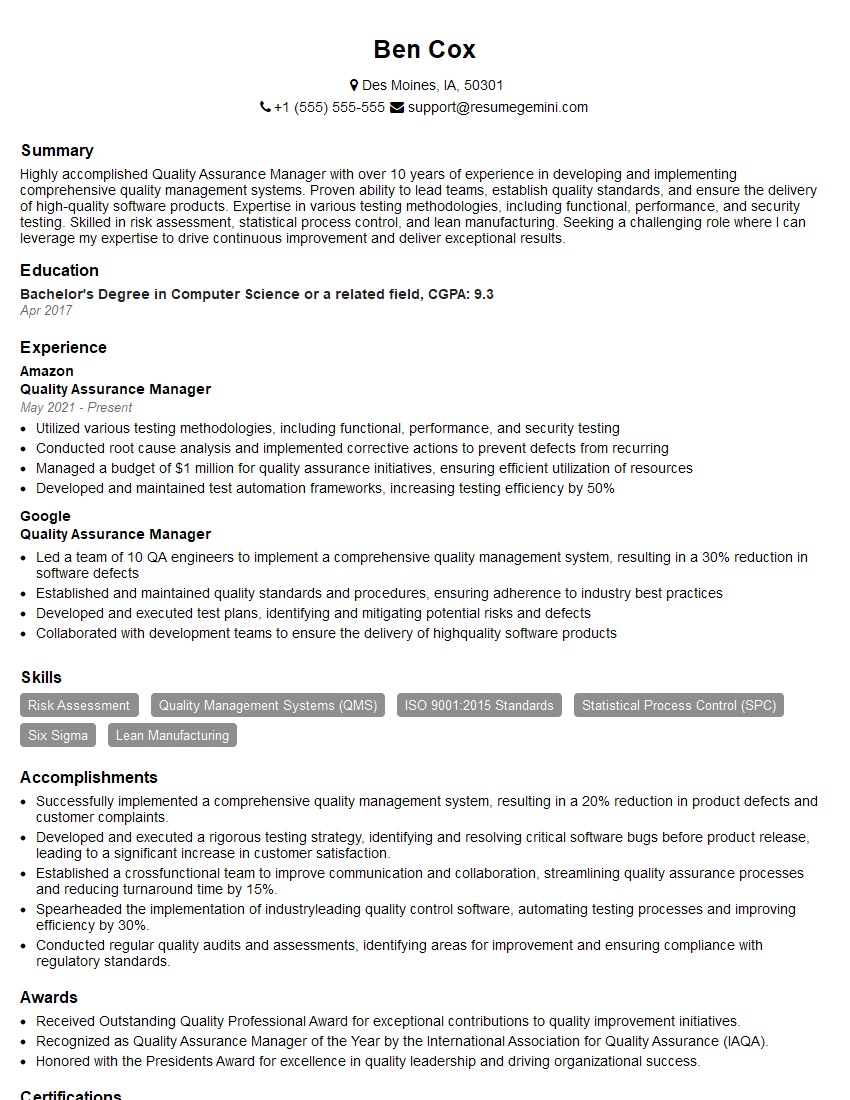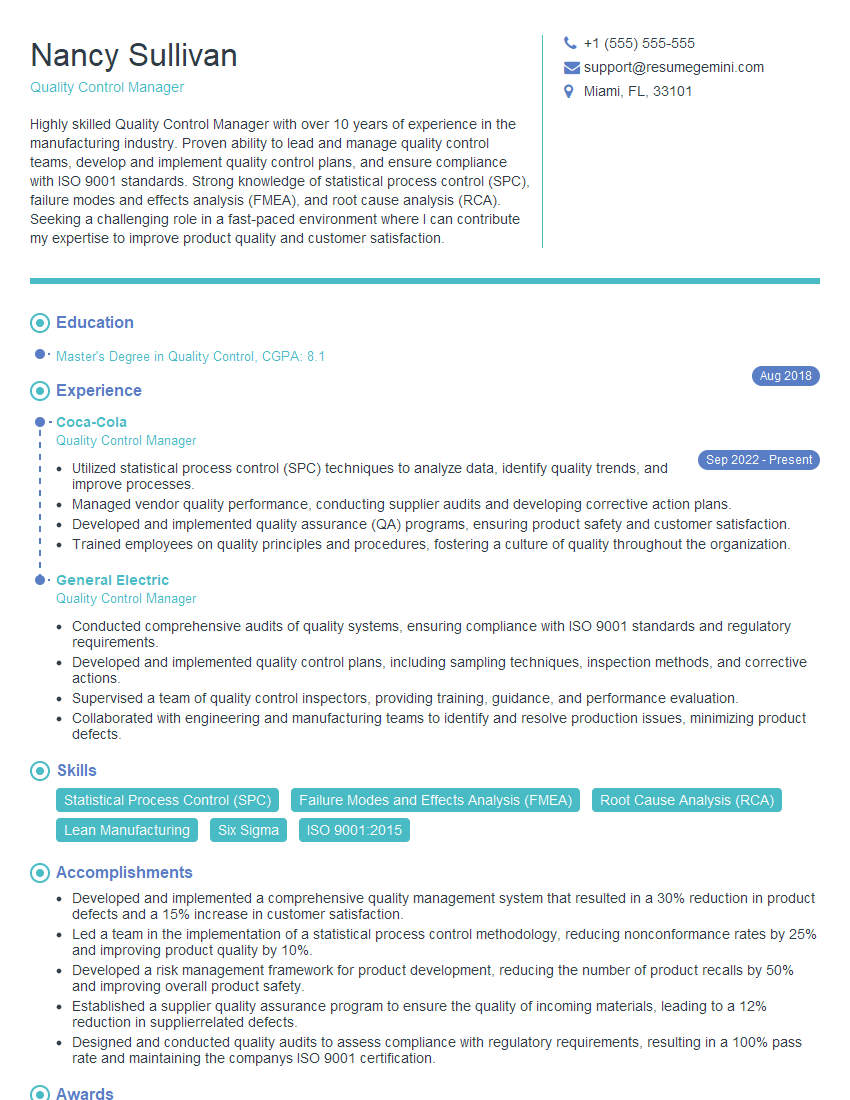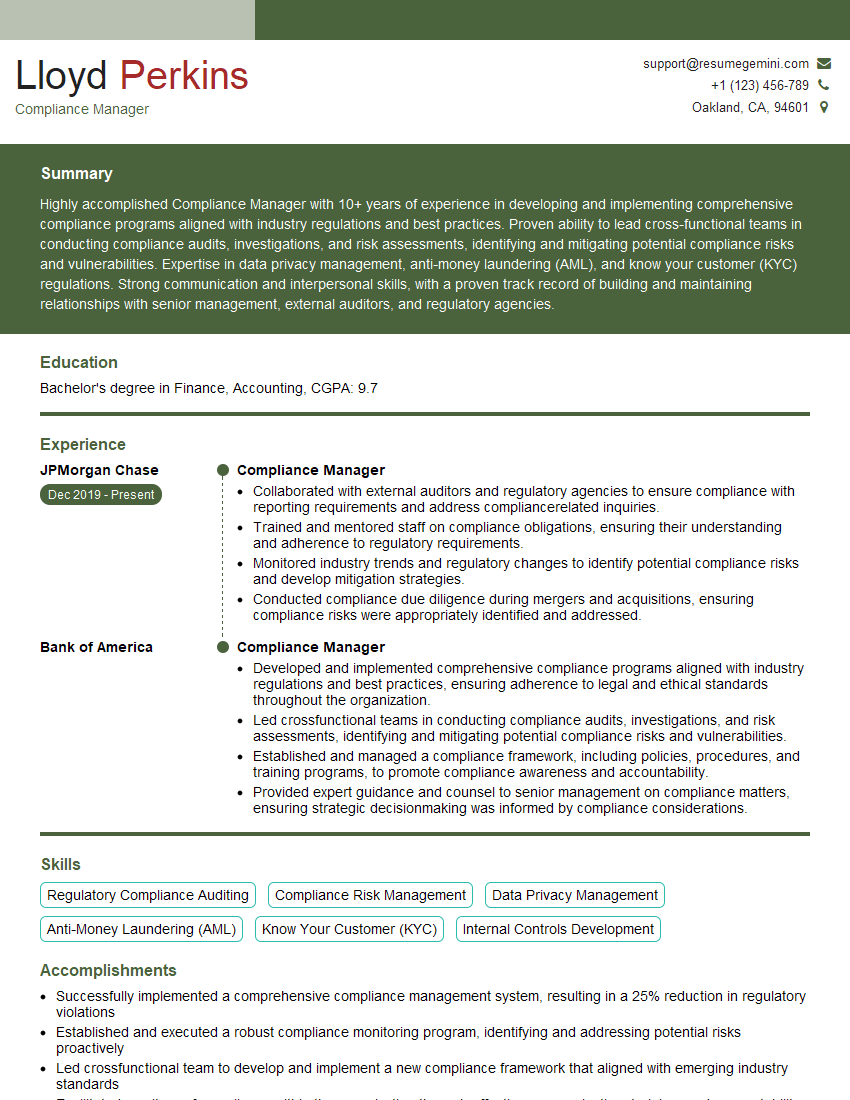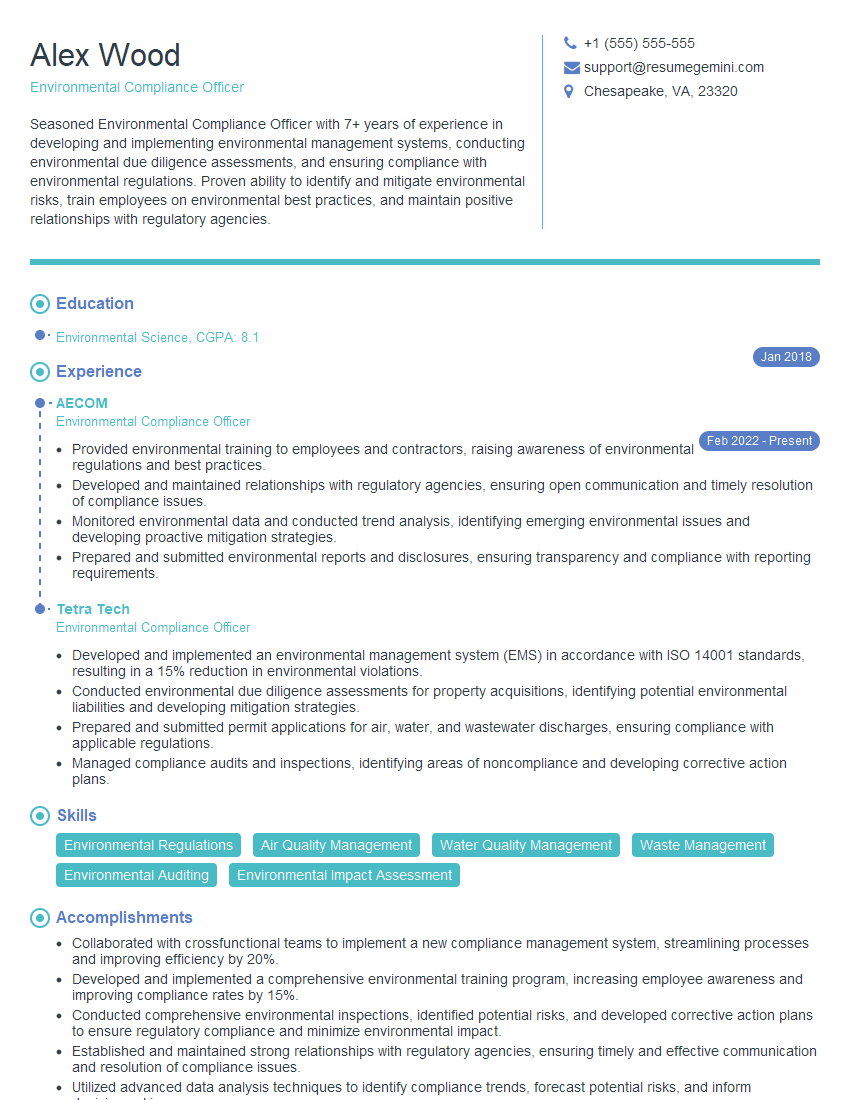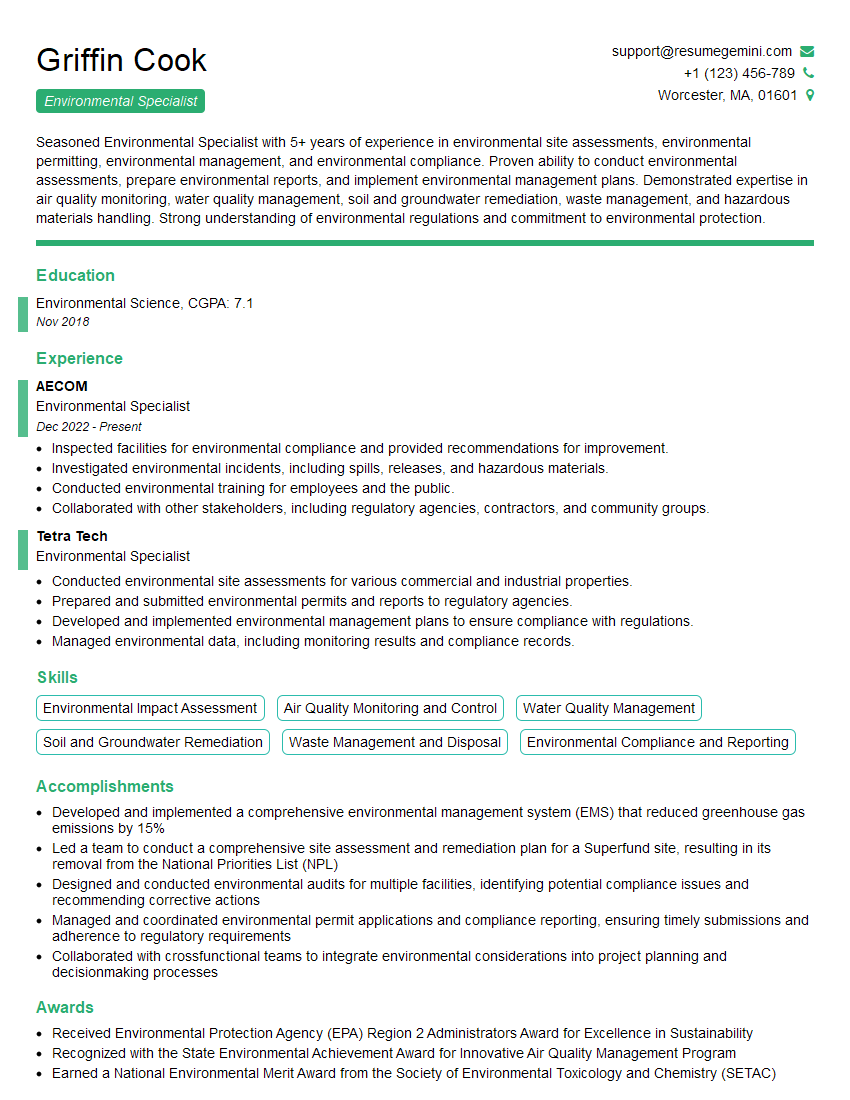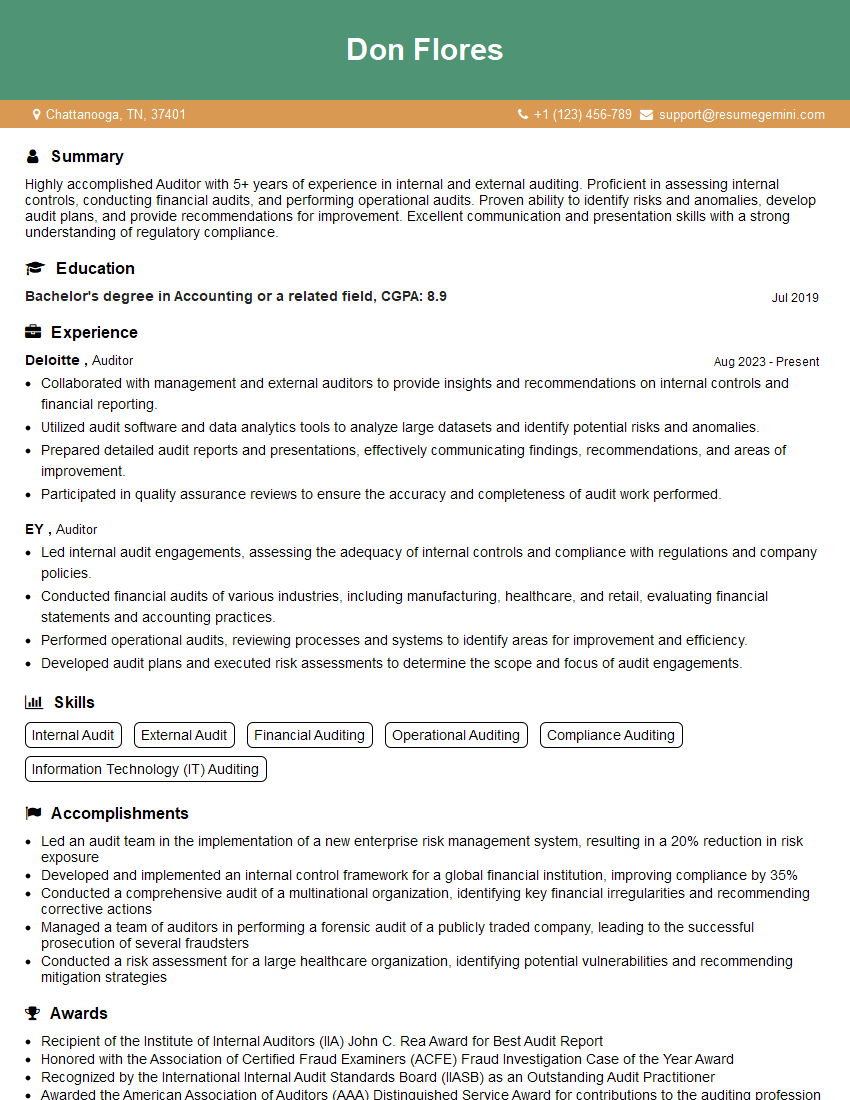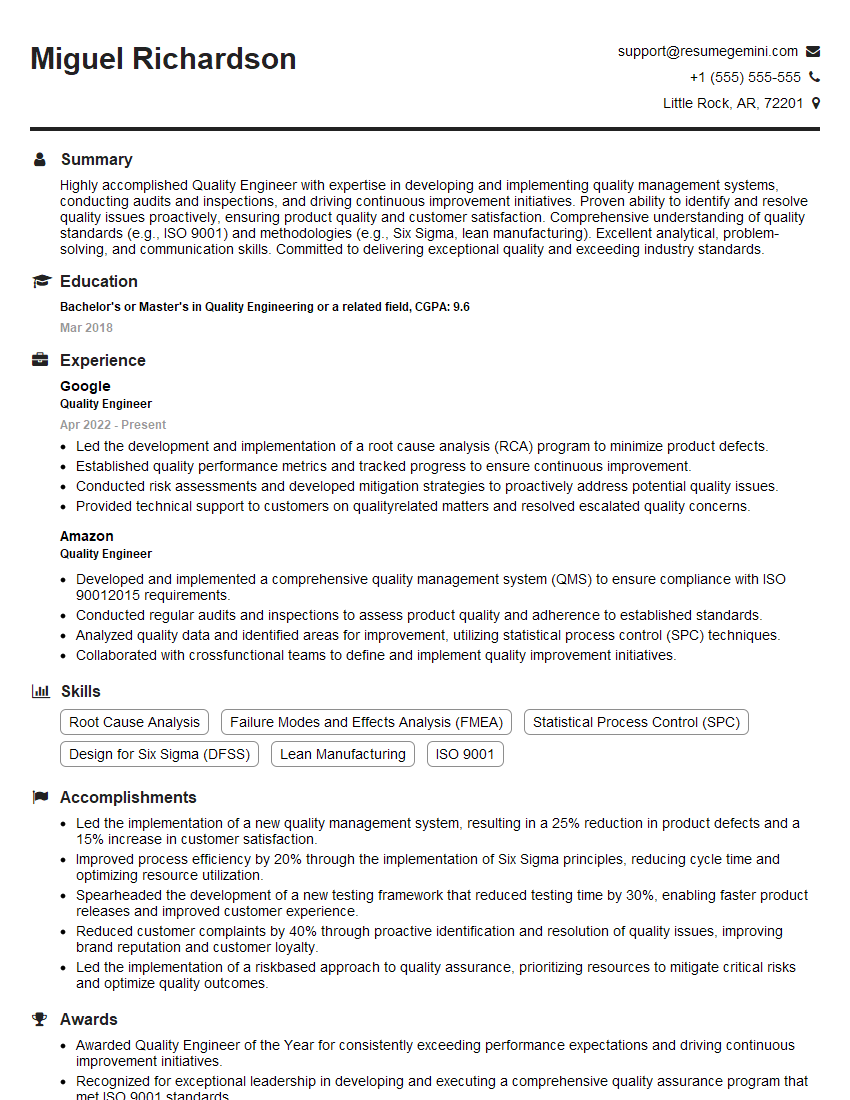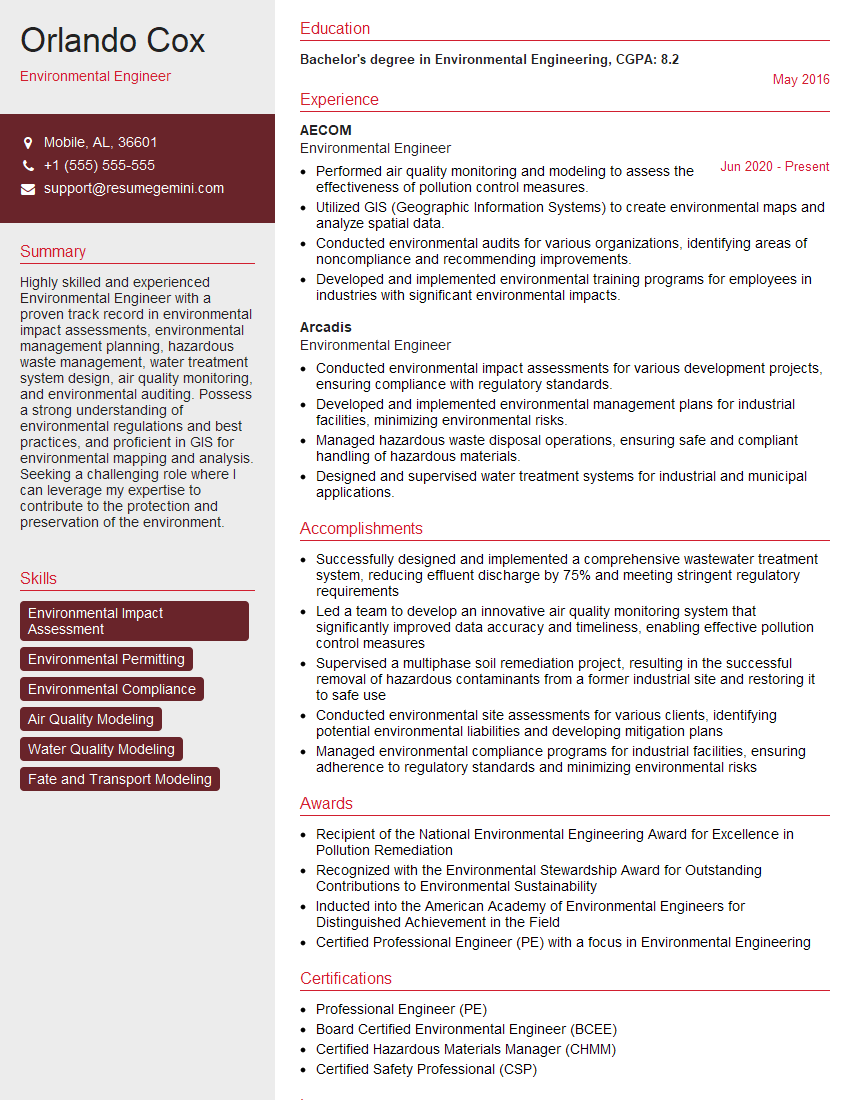Unlock your full potential by mastering the most common Knowledge of ISO 9001 and ISO 14001 Standards interview questions. This blog offers a deep dive into the critical topics, ensuring you’re not only prepared to answer but to excel. With these insights, you’ll approach your interview with clarity and confidence.
Questions Asked in Knowledge of ISO 9001 and ISO 14001 Standards Interview
Q 1. Explain the PDCA cycle in relation to ISO 9001.
The PDCA cycle, or Plan-Do-Check-Act cycle, is a fundamental framework for continuous improvement, integral to ISO 9001. It’s a cyclical process that drives iterative enhancements in a quality management system.
- Plan: This stage involves defining objectives, processes, and responsibilities. It’s about proactively identifying opportunities for improvement and establishing a plan to achieve them. For example, a company might plan to reduce customer complaint rates by implementing a new customer feedback system.
- Do: Here, the plan is implemented. This could involve training staff, modifying processes, or introducing new technologies. In our example, this would involve installing the new customer feedback system and training staff to use it.
- Check: This crucial step involves monitoring the implemented plan’s effectiveness and measuring the results against the planned objectives. Data analysis, audits, and reviews are key components. For the feedback system, this would mean analyzing the data collected, measuring customer satisfaction, and assessing the impact on complaint rates.
- Act: Based on the findings from the ‘Check’ phase, necessary actions are taken. This might involve adjustments to the implemented plan, process improvements, or the development of entirely new plans. If the new system isn’t effective enough in reducing complaints, modifications might be needed, potentially including changes to the system’s design or the staff training program.
The PDCA cycle isn’t a one-time event; it’s continuous. Organizations repeatedly cycle through these stages to achieve continuous improvement and maintain a robust quality management system.
Q 2. Describe the key differences between ISO 9001:2015 and ISO 9001:2008.
ISO 9001:2015 introduced significant changes compared to its 2008 predecessor, shifting the focus from documentation to the effectiveness of the Quality Management System (QMS).
- Risk-Based Thinking: 2015 emphasizes proactive risk assessment and management throughout the QMS, whereas 2008 focused more on reactive problem-solving. This means identifying potential risks to quality and implementing controls to prevent them.
- Process Approach: Both versions promote a process approach, but 2015 strengthens the emphasis on understanding and managing interlinked processes within the organization. This leads to a more holistic view of the QMS.
- Leadership Commitment: 2015 requires stronger top management commitment and accountability for the QMS. It reinforces that top management’s active involvement is crucial for successful implementation and continuous improvement.
- Context of the Organization: 2015 requires a thorough understanding of the organization’s internal and external context, including its stakeholders, opportunities, and threats. This helps in tailoring the QMS to the specific needs of the organization.
- Improvement: While both versions emphasize improvement, 2015 explicitly integrates continuous improvement throughout the QMS rather than treating it as a separate activity.
In essence, ISO 9001:2015 promotes a more proactive, risk-based, and holistic approach to quality management, while ISO 9001:2008 was more focused on documentation and reactive problem-solving. The shift is from a compliance-focused to a performance-driven model.
Q 3. What are the core principles of ISO 14001?
The core principles of ISO 14001 revolve around environmental responsibility and continuous improvement. They guide organizations in establishing and maintaining an effective Environmental Management System (EMS).
- Plan-Do-Check-Act (PDCA): Similar to ISO 9001, the PDCA cycle forms the basis for continuous improvement of the EMS.
- Leadership: Top management commitment and accountability are essential for effective environmental performance.
- Engagement of People: Involving employees at all levels in environmental responsibility is crucial for success.
- Environmental Aspects and Impacts: Identifying and managing environmental aspects and their potential impacts is central to the EMS.
- Lifecycle Perspective: Considering the environmental impact throughout the entire lifecycle of products and services—from design to disposal.
- Continual Improvement: The EMS should continuously improve its environmental performance.
These principles emphasize that environmental management is not just a compliance exercise but an integrated approach to achieving sustainable business practices.
Q 4. How does environmental management integrate with the overall business strategy?
Effective environmental management isn’t a separate function; it’s strategically integrated into the overall business strategy. This integration brings numerous benefits.
- Cost Savings: Reducing waste, improving energy efficiency, and optimizing resource utilization directly translate to cost reduction. For example, implementing a robust recycling program can significantly decrease waste disposal costs.
- Risk Reduction: Proactive environmental management helps mitigate potential environmental liabilities, regulatory penalties, and reputational damage. Identifying and mitigating risks associated with emissions or waste disposal reduces the likelihood of fines or negative publicity.
- Competitive Advantage: Demonstrating environmental responsibility can attract environmentally conscious customers and investors. Certifications like ISO 14001 provide a competitive edge in the marketplace.
- Improved Brand Image: A commitment to environmental sustainability enhances the organization’s brand image and reputation, making it more appealing to stakeholders.
- Innovation and Efficiency: Environmental management often drives innovation in processes and technologies, leading to increased operational efficiency.
Integrating environmental management into the business strategy requires commitment from top management, clear objectives, and integration into decision-making processes at all levels. It’s a crucial aspect of sustainable and responsible business practices.
Q 5. Explain the concept of ‘environmental aspects’ and ‘environmental impacts’.
Understanding ‘environmental aspects’ and ‘environmental impacts’ is fundamental to ISO 14001.
- Environmental Aspects: These are elements of an organization’s activities, products, or services that can interact with the environment. They are essentially the potential interactions. Examples include energy consumption, water usage, waste generation, emissions to air, and land use.
- Environmental Impacts: These are the changes to the environment, whether adverse or beneficial, resulting from an organization’s environmental aspects. They are the consequences of those interactions. For example, the impact of energy consumption could be greenhouse gas emissions, while the impact of waste generation could be soil or water contamination.
An organization must identify its environmental aspects and then evaluate their potential impacts. This allows the organization to prioritize and manage the most significant environmental issues, leading to a more effective and targeted environmental management system.
Q 6. Describe your experience conducting internal audits for ISO 9001/14001.
I have extensive experience conducting internal audits for both ISO 9001 and ISO 14001 standards. My approach is always methodical and focused on adding value.
- Planning and Preparation: Before an audit, I meticulously review the relevant documentation, including the QMS/EMS manual, procedures, and records. I develop a detailed audit plan tailored to the specific context of the audited area.
- Audit Execution: During the audit, I conduct interviews with personnel at all levels, observe processes, and review documentation to determine conformity with the standards’ requirements. I focus on evidence-based findings.
- Objective Reporting: My audit reports are clear, concise, and objective, providing factual findings and recommendations for improvement. I avoid subjective judgments and focus on verifiable evidence.
- Follow-up: After the audit, I follow up on corrective actions implemented by the organization to ensure effectiveness and continuous improvement. This feedback loop is crucial to the success of the system.
In one particular instance, during an internal audit of a manufacturing facility, I identified an area where waste management practices were inconsistent with documented procedures, leading to higher-than-necessary disposal costs and potential environmental risks. Through my report and subsequent corrective actions, the company implemented improved waste segregation and recycling strategies, resulting in cost savings and improved environmental performance.
Q 7. What are the key requirements for an effective environmental management system?
Key requirements for an effective Environmental Management System (EMS) include:
- Top Management Commitment: Active leadership and commitment are essential for driving the EMS and integrating environmental considerations into business decisions.
- Environmental Policy: A clearly defined environmental policy that establishes the organization’s commitment to environmental performance.
- Legal and Other Requirements: Compliance with all applicable environmental laws, regulations, and other requirements is crucial.
- Environmental Aspects and Impacts: Identifying, evaluating, and managing significant environmental aspects and their impacts.
- Objectives and Targets: Setting measurable environmental objectives and targets to drive performance improvement.
- Monitoring and Measurement: Establishing a system for monitoring and measuring environmental performance against objectives and targets.
- Emergency Preparedness and Response: Having plans in place to address and respond to environmental emergencies.
- Continual Improvement: Regular review and improvement of the EMS based on performance data and feedback.
- Competence, Awareness, and Communication: Ensuring employees have the necessary competence and awareness to perform their tasks effectively and that communication regarding environmental matters is effective.
An effective EMS isn’t merely about checking boxes; it’s a dynamic system that continually adapts to changing environmental and business contexts, improving performance, and reducing environmental impacts while also increasing efficiency and profitability.
Q 8. How do you ensure continual improvement within a QMS/EMS?
Continual improvement is the heart of both ISO 9001 (Quality Management Systems) and ISO 14001 (Environmental Management Systems). It’s not a one-time event but an ongoing process of enhancing performance. We ensure this through a cyclical approach, often visualized as the Plan-Do-Check-Act (PDCA) cycle.
- Plan: We identify areas for improvement, setting objectives and determining the necessary resources. This involves analyzing data from audits, customer feedback, and performance indicators to pinpoint weaknesses.
- Do: We implement the changes planned, perhaps by introducing new training programs, modifying processes, or investing in new equipment.
- Check: We monitor the effectiveness of the implemented changes. This involves data collection and analysis to see if the changes are achieving the desired results. Audits and management reviews are crucial here.
- Act: Based on the ‘Check’ phase, we either standardize successful improvements or make further adjustments. If the changes aren’t effective, we go back to the ‘Plan’ stage and refine our approach.
For example, in a manufacturing setting, we might identify high scrap rates during the ‘Plan’ phase. In the ‘Do’ phase, we could implement a new training program for operators. ‘Check’ would involve tracking the scrap rate over time. Finally, in ‘Act’, we might standardize the new training program or make adjustments based on the results.
Q 9. What is a corrective action and how is it implemented?
A corrective action addresses the root cause of a nonconformity (something that doesn’t meet requirements) to prevent recurrence. It’s different from a preventive action, which anticipates potential problems. Implementing a corrective action involves several steps:
- Identify the nonconformity: This involves clearly defining the issue, when it occurred, and its impact.
- Investigate the root cause: This is crucial; simply fixing the symptom won’t prevent future occurrences. We use tools like fishbone diagrams or 5 Whys to identify the underlying problem.
- Develop and implement a corrective action: This involves defining specific actions to eliminate the root cause. The action should be measurable and verifiable.
- Verify the effectiveness: After implementation, we monitor to ensure the corrective action solved the problem and prevented recurrence.
- Document everything: All steps, from identification to verification, are thoroughly documented and stored within the QMS/EMS.
For instance, if a production line consistently produces defective products due to faulty equipment, the corrective action would involve repairing or replacing the equipment, retraining staff on its operation, and perhaps implementing a more rigorous preventative maintenance schedule.
Q 10. How do you handle nonconformances within ISO 9001/14001 framework?
Nonconformances in ISO 9001/14001 are deviations from planned activities or requirements. Handling them involves a structured approach:
- Identify and Document: Record all nonconformances, including details like date, location, and description.
- Investigate: Determine the root cause using appropriate tools. This helps prevent recurrence.
- Contain: Implement immediate actions to prevent further nonconformances (e.g., stopping production of faulty products).
- Corrective Action: Develop and implement actions to eliminate the root cause (as explained in the previous answer).
- Verify Effectiveness: Monitor to ensure the corrective action has solved the problem.
- Record and Review: Document all steps, including the actions taken and their effectiveness. Management reviews should track the effectiveness of corrective actions to improve the QMS/EMS.
Imagine a case where a waste disposal company exceeds its permitted emission limits. The nonconformance would be documented. Investigation might reveal a malfunctioning filter. Containment would be immediate filter shutdown. Corrective action would involve filter repair, maintenance improvements, and staff retraining. Verification would include monitoring emissions levels after the repair.
Q 11. What are the main elements of a documented management system?
A documented management system comprises several key elements:
- Quality/Environmental Policy: A formal statement of the organization’s commitment to quality and/or environmental protection.
- Objectives and Targets: Specific, measurable, achievable, relevant, and time-bound (SMART) goals that support the policy.
- Procedures: Step-by-step instructions on how to perform specific tasks or processes.
- Records: Documentation of activities, results, and evidence of compliance.
- Forms and Templates: Standardized formats for data collection and recording information.
- Work Instructions: Detailed guidance for specific jobs or tasks.
- Management Review Records: Minutes of management review meetings and their outcomes.
- Audit Records: Documentation of audits and their findings.
Think of it like a recipe book for your entire organization. The policy is the overall goal (delicious cake!), procedures are the steps (mixing ingredients), records are proof of following those steps (photo of the cake). This documentation ensures consistency, traceability, and improvement.
Q 12. Explain the role of management review in ISO 9001 and ISO 14001.
The management review is a critical process in both ISO 9001 and ISO 14001. It’s a high-level assessment of the effectiveness of the QMS/EMS. It ensures that the system remains suitable, adequate, and effective in achieving its objectives.
- Review of Performance: Examining performance indicators, audit results, customer feedback, and other relevant data.
- Assessment of Opportunities for Improvement: Identifying areas where the system can be enhanced.
- Resource Allocation: Determining the necessary resources to support improvements.
- Communication of Outcomes: Sharing the review findings and decisions with relevant personnel.
- Action Planning: Defining actions to address identified opportunities for improvement.
It’s like a yearly check-up for your QMS/EMS. The management team reviews the ‘patient’s’ health (performance), identifies potential problems, and plans for necessary improvements. The minutes of the meeting serve as documentation of this process.
Q 13. How do you measure the effectiveness of your QMS/EMS?
Measuring the effectiveness of a QMS/EMS involves monitoring various key performance indicators (KPIs). These KPIs are chosen based on the organization’s specific context and objectives. Some common examples include:
- Customer Satisfaction: Measured through surveys, feedback forms, and complaint analysis.
- Nonconformances: Tracking the number and type of nonconformances to identify trends and areas for improvement.
- Corrective Action Effectiveness: Monitoring the success rate of corrective actions in preventing recurrence.
- Environmental Compliance: Measuring adherence to environmental regulations and permits.
- Waste Reduction: Tracking the amount of waste generated and its impact.
- Energy Consumption: Monitoring energy usage to identify areas for conservation.
By tracking these KPIs over time, we can assess the effectiveness of the QMS/EMS and identify areas needing attention. Data analysis tools and regular reporting are crucial for this monitoring and evaluation.
Q 14. Describe your experience with environmental legislation and compliance.
My experience with environmental legislation and compliance is extensive. I’ve worked with organizations to ensure compliance with various regulations, including permits, emission standards, waste management guidelines, and other relevant local, national, and international laws. This involves:
- Regular updates on legal requirements: Staying informed about changes in environmental legislation and their impact on the organization.
- Environmental impact assessments: Conducting assessments to understand potential environmental consequences of activities.
- Permitting and licensing: Ensuring compliance with necessary permits and licenses related to operations.
- Emergency preparedness planning: Developing plans to respond to environmental emergencies and prevent environmental incidents.
- Monitoring and reporting: Tracking environmental performance indicators, conducting audits, and preparing environmental reports.
For example, I worked with a manufacturing plant to gain compliance with stricter emission standards. This involved implementing new pollution control equipment, adjusting operating procedures, and providing extensive training to staff. This required close collaboration with environmental regulatory agencies and ensured the plant avoided penalties and environmental damage.
Q 15. What are your strategies for reducing environmental impact within an organization?
Reducing an organization’s environmental impact requires a holistic approach, integrating environmental considerations into every aspect of its operations. My strategy involves a multi-pronged approach focusing on waste reduction, energy efficiency, sustainable sourcing, and pollution prevention.
Waste Reduction: This includes implementing robust waste segregation programs, promoting recycling and composting initiatives, minimizing packaging, and exploring options for waste-to-energy solutions. For example, in a manufacturing setting, we could implement a closed-loop system where waste materials are reused in the production process, significantly reducing landfill waste.
Energy Efficiency: We would conduct energy audits to identify areas for improvement, invest in energy-efficient equipment and technologies (like LED lighting or high-efficiency motors), and optimize energy consumption through behavioral changes and process improvements. Imagine switching to renewable energy sources like solar or wind power for a substantial reduction in carbon footprint.
Sustainable Sourcing: Prioritizing suppliers committed to sustainable practices, using recycled materials, and sourcing products with minimal environmental impact throughout their lifecycle. This could involve working with certified suppliers who adhere to environmental standards and tracking the environmental performance of our supply chain.
Pollution Prevention: Implementing measures to prevent pollution at its source, through process optimization, improved emission control systems, and responsible handling and disposal of hazardous materials. This might include investing in wastewater treatment plants or implementing stricter air quality monitoring and control mechanisms.
Ultimately, success requires continuous monitoring, improvement, and employee engagement, fostering a culture of environmental responsibility within the organization.
Career Expert Tips:
- Ace those interviews! Prepare effectively by reviewing the Top 50 Most Common Interview Questions on ResumeGemini.
- Navigate your job search with confidence! Explore a wide range of Career Tips on ResumeGemini. Learn about common challenges and recommendations to overcome them.
- Craft the perfect resume! Master the Art of Resume Writing with ResumeGemini’s guide. Showcase your unique qualifications and achievements effectively.
- Don’t miss out on holiday savings! Build your dream resume with ResumeGemini’s ATS optimized templates.
Q 16. How do you handle stakeholder engagement related to environmental performance?
Stakeholder engagement is crucial for successful environmental performance. It involves building strong relationships and actively communicating with various stakeholders to understand their concerns, incorporate their feedback, and ensure transparency. My approach involves:
Identifying Key Stakeholders: This includes employees, customers, suppliers, local communities, regulatory bodies, and investors. Each group has unique interests and concerns regarding the organization’s environmental performance.
Communication and Consultation: Regularly communicating environmental performance data, plans, and progress through reports, meetings, and surveys. Actively seeking feedback and addressing stakeholder concerns promptly and transparently is key. This may involve creating regular newsletters, holding open forums, or publishing environmental sustainability reports.
Collaboration and Partnership: Working collaboratively with stakeholders to develop and implement environmental initiatives. For example, collaborating with local communities on environmental projects or partnering with suppliers to improve their environmental performance.
Transparency and Accountability: Publicly reporting environmental performance data and demonstrating accountability for environmental commitments. This might involve publishing environmental impact assessments or participating in industry sustainability initiatives.
By effectively engaging with stakeholders, organizations can build trust, improve environmental performance, and foster a sense of shared responsibility.
Q 17. Explain the importance of document control within ISO 9001.
Document control in ISO 9001 is essential for maintaining the integrity and accuracy of the Quality Management System (QMS). It ensures that all documents relevant to the QMS are identified, reviewed, approved, distributed, and updated as needed. This prevents confusion, ensures consistency, and supports traceability.
Identification and Control: All documents relevant to the QMS are identified, numbered, version-controlled, and reviewed regularly to ensure accuracy and relevance. This might include procedures, work instructions, forms, records, and drawings.
Distribution and Access: Controlled distribution ensures that only authorized personnel have access to relevant documents. This prevents unauthorized changes or misuse of information.
Review and Update: Documents are periodically reviewed and updated to reflect changes in processes, regulations, or best practices. An effective system maintains a clear history of revisions.
Obsolete Documents: A system is in place to identify and remove obsolete documents to avoid confusion and ensure that everyone uses the most current information.
Storage and Retention: Appropriate storage and retention procedures ensure that documents are readily accessible and preserved for the required duration.
Effective document control avoids costly errors, ensures regulatory compliance, and ultimately supports consistent, high-quality product and service delivery.
Q 18. Describe your experience with risk assessment in relation to environmental aspects.
Risk assessment related to environmental aspects is a critical component of ISO 14001. It involves systematically identifying, analyzing, and evaluating potential environmental impacts associated with an organization’s activities, products, and services. My experience encompasses:
Identifying Environmental Aspects: This involves systematically identifying all environmental aspects (elements of an organization’s activities, products, or services that can interact with the environment) of the organization’s operations. For example, in a manufacturing plant, this might include air emissions, wastewater discharge, and waste generation.
Determining Environmental Impacts: Evaluating the significance of identified environmental aspects. This may involve considering the likelihood and severity of the potential impact (e.g., air emissions could lead to air pollution and respiratory problems).
Risk Assessment Matrix: Using a risk assessment matrix to prioritize environmental risks based on their likelihood and severity. This allows the focus to be placed on the most significant risks first.
Developing Control Measures: Implementing appropriate controls to mitigate the identified environmental risks. For example, investing in pollution control technology or implementing a waste management plan.
Monitoring and Review: Regularly monitoring the effectiveness of implemented controls and reviewing the risk assessment process to ensure its continued relevance and accuracy. This may involve periodic audits and reviews of environmental performance data.
Effective environmental risk assessment helps prevent pollution, ensures compliance, and protects the environment.
Q 19. What is your understanding of life cycle assessment (LCA)?
Life Cycle Assessment (LCA) is a comprehensive method for evaluating the environmental impacts of a product or service throughout its entire life cycle, from raw material extraction to end-of-life disposal. It considers all stages: raw material acquisition, manufacturing, transportation, use, and disposal or recycling.
An LCA involves:
Goal and Scope Definition: Clearly defining the purpose of the LCA and the boundaries of the assessment. This includes defining the product system, functional unit, and geographic scope.
Inventory Analysis: Quantifying the inputs and outputs of energy, materials, and emissions associated with each stage of the product’s life cycle.
Impact Assessment: Evaluating the environmental significance of the identified inputs and outputs, using various impact categories like global warming potential, ozone depletion, and acidification.
Interpretation: Analyzing the results of the impact assessment to identify the environmental hotspots in the product’s life cycle and informing improvement strategies.
LCAs provide valuable insights into the environmental performance of products and services, supporting informed decision-making and driving improvements in sustainability.
Q 20. How do you ensure compliance with relevant environmental regulations?
Ensuring compliance with environmental regulations is crucial for any organization. My approach is proactive and systematic:
Identification of Applicable Regulations: Thoroughly identifying all applicable local, regional, national, and international environmental regulations relevant to the organization’s activities. This requires ongoing monitoring of legislative changes.
Implementation of Compliance Programs: Developing and implementing programs to ensure compliance with all identified regulations. This may include establishing procedures, training personnel, and implementing monitoring systems.
Record Keeping and Documentation: Maintaining accurate and complete records of compliance activities, including permits, licenses, monitoring data, and compliance audits.
Audits and Inspections: Conducting regular internal audits and inspections to ensure that the organization’s environmental management system (EMS) is effective and that compliance is maintained.
Continuous Improvement: Continuously improving the EMS to enhance environmental performance and maintain compliance. This may involve implementing new technologies, improving processes, or strengthening training programs.
Responding to Non-Compliance: Having a clear process for addressing non-compliance issues promptly and effectively, implementing corrective actions, and preventing recurrence.
Proactive compliance minimizes risks, avoids penalties, and fosters a culture of environmental responsibility.
Q 21. Explain the concept of ‘environmental performance indicators’ (EPIs).
Environmental Performance Indicators (EPIs) are metrics used to track and measure an organization’s environmental performance. They provide quantitative data to monitor progress towards environmental goals, identify areas for improvement, and demonstrate accountability.
Examples of EPIs include:
Energy Consumption: Tracking kilowatt-hours (kWh) of energy consumed per unit of production or per square meter of facility space.
Waste Generation: Measuring the amount of waste generated per unit of production or per employee.
Water Consumption: Monitoring liters of water consumed per unit of production or per employee.
Greenhouse Gas Emissions: Tracking tons of carbon dioxide equivalent (CO2e) emitted per unit of production or per employee.
Air Emissions: Measuring the amount of specific pollutants released into the atmosphere.
Recycling Rate: Calculating the percentage of waste that is recycled.
Effective EPIs are specific, measurable, achievable, relevant, and time-bound (SMART). They provide valuable insights into environmental performance and support data-driven decision-making.
Q 22. Describe your experience in developing and implementing environmental programs.
Developing and implementing environmental programs requires a systematic approach, aligning with ISO 14001 principles. It begins with understanding the organization’s environmental aspects – significant environmental impacts arising from its operations. For example, a manufacturing plant might identify energy consumption, waste generation, and water usage as key aspects.
Next, we establish environmental objectives and targets, setting measurable goals for improvement. This might involve reducing energy consumption by 15% within a year or decreasing waste sent to landfill by 10%. These targets are crucial for tracking progress. We then design programs to meet those targets – perhaps implementing a waste reduction plan, investing in energy-efficient equipment, or switching to renewable energy sources.
Implementation includes training employees on new procedures, monitoring performance regularly, and conducting regular internal audits to ensure compliance. Crucially, we must establish a mechanism for corrective actions – addressing any deviations from targets. In a past role, I led the implementation of a waste management program in a food processing facility, resulting in a 20% reduction in landfill waste within six months through improved sorting and recycling initiatives. This involved extensive employee training and the introduction of new waste segregation procedures.
Q 23. How do you communicate environmental performance to stakeholders?
Communicating environmental performance is vital for transparency and stakeholder engagement. We employ various methods tailored to the specific audience. For example, we might create concise reports with key performance indicators (KPIs) like energy consumption, waste generation, and emissions for senior management. These reports usually include graphs and charts for easy visualization and comparison with past performance or targets.
For external stakeholders – such as customers, investors, and the local community – we might prepare sustainability reports outlining our environmental commitments, achievements, and future goals. These reports often follow established guidelines like the Global Reporting Initiative (GRI) standards for consistent reporting. We could also participate in industry events or publish articles to disseminate our performance data. Furthermore, regular stakeholder meetings and feedback mechanisms are essential to ensure open communication and address their concerns.
Finally, a user-friendly website or online dashboard can provide real-time access to environmental performance data for all stakeholders. In one project, I created an interactive dashboard that visualized our environmental progress, making it accessible and engaging for all stakeholders.
Q 24. Explain the role of training and competency in maintaining a QMS/EMS.
Training and competency are cornerstones of maintaining a robust Quality Management System (QMS) and Environmental Management System (EMS). They ensure that personnel understand their roles, responsibilities, and the procedures necessary to comply with the standards. This involves both initial training upon joining the organization and ongoing refresher training to keep knowledge up-to-date.
For a QMS, training might cover quality policies, procedures, documentation control, and internal auditing. For an EMS, it would encompass environmental policies, permits, emergency procedures, and waste management protocols. Competency is assessed through various methods – observation during work, testing, or certification programs.
Without proper training and competency, errors can occur leading to non-conformances. For example, inadequate training on waste segregation could lead to incorrect waste disposal, harming the environment and violating regulations. I’ve witnessed firsthand the benefits of a comprehensive training program leading to improved compliance and employee engagement. We implemented a modular training system that provided customized training to different departments, improving individual understanding and engagement.
Q 25. How do you address conflicts between quality and environmental objectives?
Conflicts between quality and environmental objectives are possible. For example, striving for high production speed might lead to increased energy consumption and waste generation. Resolving these conflicts requires a balanced approach, prioritizing sustainable practices without compromising quality. This often involves a collaborative process.
First, identify the root cause of the conflict. Then, explore alternative solutions that minimize the negative impact on both quality and the environment. This might involve investing in more efficient equipment or implementing lean manufacturing principles to reduce waste while maintaining production levels. In my experience, multidisciplinary teams are crucial for finding effective solutions. We utilized a structured problem-solving approach, using tools such as root cause analysis and Pareto charts. In one case, a conflict between fast production and reduced water consumption was resolved by implementing a water recycling system, improving efficiency and reducing waste.
Q 26. Describe a situation where you had to improve a QMS/EMS process.
In a previous role, we identified inefficiencies in our non-conformity reporting process. The system was cumbersome, leading to delays in corrective actions. The process involved paper-based forms, manual data entry, and multiple approvals. This created bottlenecks and hampered the effectiveness of the QMS/EMS.
To improve this, we implemented a digital non-conformity management system. This streamlined the reporting process, reducing paperwork, accelerating investigations, and enabling real-time tracking of corrective actions. We used a dedicated software solution allowing employees to submit reports electronically, automatically assigning them to relevant departments. The system also generated reports to track trends and identify areas for improvement. The implementation led to a significant reduction in processing time, enhanced data accuracy, and improved overall efficiency of the system.
Q 27. What are the benefits of integrating ISO 9001 and ISO 14001?
Integrating ISO 9001 (Quality Management) and ISO 14001 (Environmental Management) offers significant benefits. It leads to a more streamlined and efficient management system, reducing duplication of effort and improving overall resource allocation. This integrated approach fosters a culture of continuous improvement across both quality and environmental performance.
Benefits include reduced costs through efficient resource management, improved regulatory compliance, enhanced stakeholder confidence through demonstration of commitment to both quality and environmental protection, and a more sustainable and responsible business approach. Integrating the standards often means combining internal audits and management reviews, leading to a more holistic view of the organization’s performance. In essence, it’s a more efficient and effective way to manage the organisation’s overall sustainability and quality performance.
Q 28. Explain your understanding of the high-level structure of ISO management system standards.
The high-level structure of ISO management system standards, including ISO 9001 and ISO 14001, follows a common framework known as the Annex SL. This structure ensures consistency across various ISO standards, facilitating easier integration and understanding. Key elements include:
- Context of the organization: Understanding the internal and external issues relevant to its purpose and strategic direction.
- Leadership: Demonstrating leadership and commitment from top management.
- Planning: Setting objectives and targets aligned with the organization’s strategy.
- Support: Providing the necessary resources and infrastructure.
- Operation: Implementing and managing the processes required to achieve objectives.
- Performance evaluation: Monitoring, measuring, and evaluating performance against objectives.
- Improvement: Continuously improving the management system through corrective actions and preventive measures.
This structure provides a clear roadmap for organizations to develop and implement effective management systems, promoting efficiency, consistency, and continuous improvement. The common structure allows for easy integration of different ISO management systems, minimizing overlapping efforts and maximizing synergies.
Key Topics to Learn for Knowledge of ISO 9001 and ISO 14001 Standards Interview
- ISO 9001: Quality Management Systems: Understanding the core principles, clauses, and requirements. Focus on the Plan-Do-Check-Act (PDCA) cycle and its practical application within an organization.
- ISO 14001: Environmental Management Systems: Grasping the key elements, including environmental aspects, impacts, legal compliance, and continuous improvement. Be prepared to discuss environmental policy development and implementation.
- Internal Audits: Know the process of conducting internal audits for both ISO 9001 and ISO 14001, including identifying non-conformances and recommending corrective actions. Practice describing your audit experience and findings.
- Documentation and Records Management: Understand the importance of maintaining accurate and up-to-date documentation for both standards. Be ready to discuss record control and retention policies.
- Management Review: Familiarize yourself with the purpose and process of management reviews for both systems. Be able to explain how they contribute to continuous improvement.
- Risk-Based Thinking: Demonstrate understanding of how risk-based thinking is integrated into both ISO 9001 and ISO 14001, including risk assessment and mitigation strategies.
- Practical Application: Be prepared to discuss real-world examples of how you’ve applied these standards in previous roles. Highlight successes and lessons learned.
- Differences and Synergies: Understand the key differences between ISO 9001 and ISO 14001, as well as the potential synergies and benefits of integrating both systems within an organization.
- Continuous Improvement Methods: Demonstrate familiarity with various continuous improvement methodologies (e.g., Kaizen, Lean) and their application within the context of ISO 9001 and ISO 14001.
Next Steps
Mastering ISO 9001 and ISO 14001 knowledge significantly enhances your career prospects in quality management and environmental sustainability. A strong understanding of these standards demonstrates your commitment to excellence and responsible business practices, making you a highly valuable asset to any organization. To maximize your job search success, create an ATS-friendly resume that highlights your relevant skills and experience. ResumeGemini is a trusted resource that can help you build a professional and effective resume. We provide examples of resumes tailored to showcasing expertise in ISO 9001 and ISO 14001 Standards – take a look to see how you can best present your qualifications.
Explore more articles
Users Rating of Our Blogs
Share Your Experience
We value your feedback! Please rate our content and share your thoughts (optional).
What Readers Say About Our Blog
This was kind of a unique content I found around the specialized skills. Very helpful questions and good detailed answers.
Very Helpful blog, thank you Interviewgemini team.
